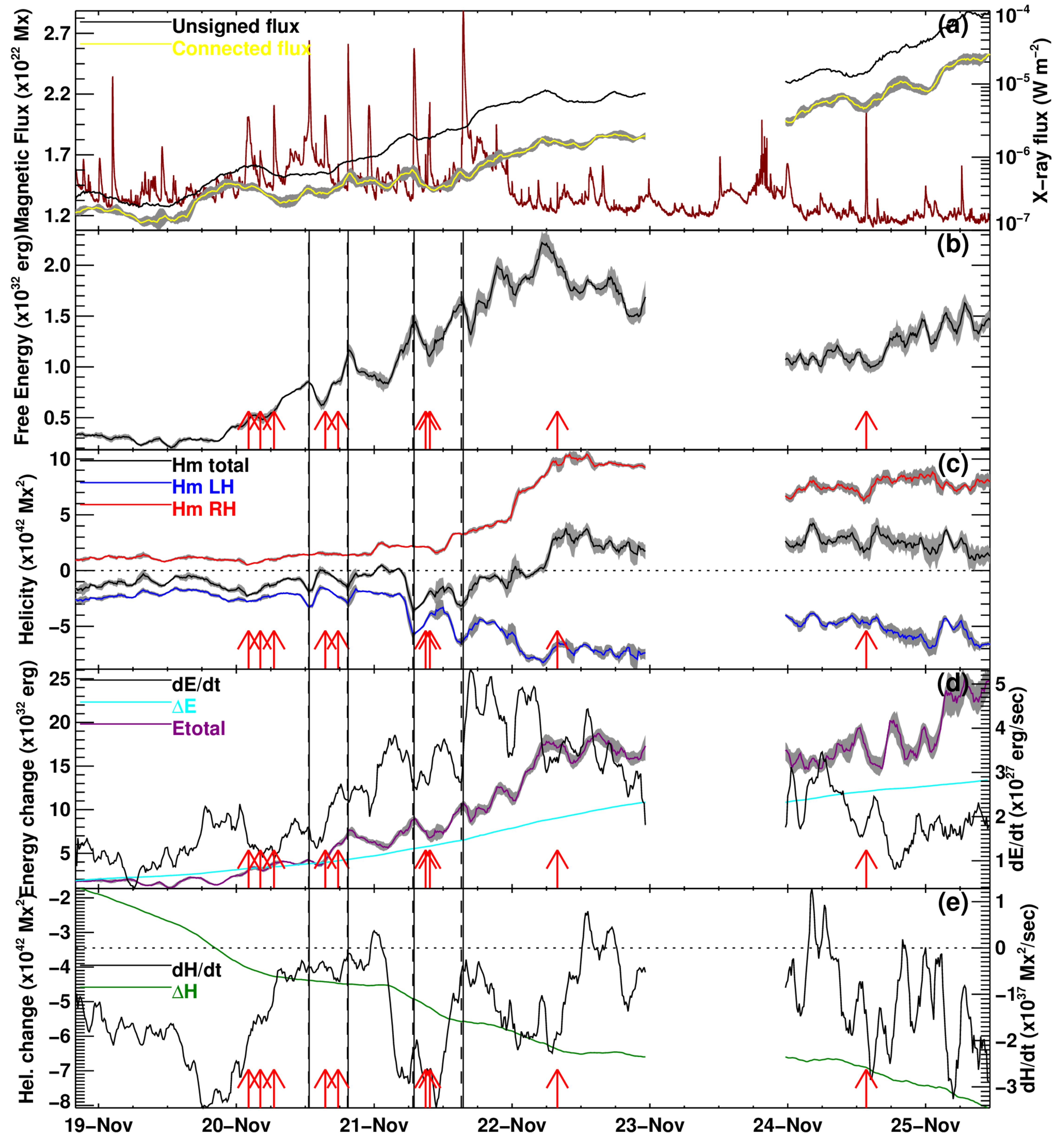E. Liokati1, A. Nindos1, & M. K. Georgoulis2
1 Section of Astrogeophysics, Department of Physics, University of Ioannina, 45110, Greece
2 Research Center for Astronomy and Applied Mathematics, Academy of Athens, Athens, 11527, Greece
Free magnetic energy (i.e. the non-potential part of the magnetic energy due to electric currents) and magnetic helicity (a conserved quantity describing the twist, writhe and linkage a set of magnetic flux tubes, e.g. see the review [1]) are two fundamental physical parameters for the study of the magnetic origin of solar eruptions, such as coronal mass ejections (CMEs) and flares. However, reports about eruptive active regions (ARs) featuring comparable amounts of positive and negative helicity budgets are scarce. Using vector magnetograms from the HMI/SDO and a magnetic connectivity-based (CB)[2] method, we calculated the instantaneous relative magnetic helicity and free magnetic energy budgets for several days in two NOAA ARs, namely AR11890 and AR11618, both with complex photospheric magnetic field configurations. The ARs produced several major eruptive flares while the evolution of their photospheric magnetic field was different: a primary flux decay for AR11890 and a primary flux emergence for AR11618. The evolution of the magnetic configuration of both ARs is presented in Figure 1, where we show snapshots of the normal field component (Bz). The above trends are also illustrated in Figures 2a and 3a, respectively, where we show the evolution of the total unsigned magnetic flux.
Figure 1| Selected images of the normal component of the photospheric field taken by the HMI during the study interval. Top three rows: AR11890. The green arrow marks the area where intense magnetic flux decay occurred, while the blue arrow shows the location of a parasitic positive polarity at a later stage during the flux decay episode. The field of view of each panel is 571″ × 387″. Bottom four rows: AR11618. The red arrows indicate sites of major flux emergence while the yellow boxes enclose areas whose magnetic flux was affected by cancellation. The field of view of each panel is 611″ × 291″.
Results of relative magnetic helicity and free magnetic energy calculations for both ARs are presented in Figures 2 and 3. Throughout much of their evolution both ARs featured substantial budgets of free magnetic energy and of both positive and negative helicity. In fact, the imbalance between the signed components of their helicity was as low as in the quiet Sun and their net helicity eventually changed sign 14-19 hours after their last major flare. Despite this incoherence, the eruptions occurred at times of net helicity peaks that were co-temporal with peaks in the free magnetic energy. The percentage losses, associated with the eruptive flares, in the normalized free magnetic energy were significant, in the range of ~10-60%. For the magnetic helicity, changes ranged from ~25% to the removal of the entire excess helicity of the prevailing sign, leading to
a roughly zero net helicity, but with significant equal and opposite budgets of both helicity senses.
Figure 2| Time profiles of magnetic properties of AR11890. (a) Total unsigned magnetic flux, unsigned connected magnetic flux used in the CB-based method, and X-ray flux from the GOES 1-8 Å channel (black, yellow, and maroon curves, respectively). (b) Free magnetic energy. (c) Right-handed, left-handed, and net helicity (red, blue, and black curves,
respectively). (d) Magnetic energy injection rate, the corresponding accumulated energy, ΔE, and the total energy from the CB method (black, cyan, and purple curves, respectively). (e) Helicity injection rate and the corresponding accumulated helicity, ΔH, from flux-integration method (black and green curves, respectively). The vertical straight lines indicate the start and peak times of M- and X-class flares (all of them being eruptive) while arrows indicate the peak time of C-class flares (all of them being confined). The gray bands indicate applicable uncertainties.
Respective values ranged from (0.3-2) × 1032 erg and (1.3-20) × 1042 Mx2 for energy and helicity losses. The removal of the slowly varying background of the free energy and helicity (either the net helicity or the prevailing signed component of helicity) time series revealed that all eruption-related peaks for both quantities exceeded the 2σ levels of their detrended time series. There was no eruption when only one or none of these quantities exceeded its 2σ level.
Our results demonstrate that differently evolving ARs may still produce major eruptive flares even when, in addition to the accumulation of significant free magnetic energy budgets, they accumulate large amounts of both negative and positive helicity without a strong dominance of one handedness over the other. In most cases, these excess budgets appear as localized peaks, co-temporal with the flare peaks, in the time series of free magnetic energy and helicity. Eruptions occur when both magnetic free energy and relative helicity exceed 2σ thresholds above their respective background.
This work is based on a paper that was published in A&A Ref [3].
References
[1] Pevtsov, A. A., Berger, M. A., Nindos, A., Norton, A. A., & van Driel-Gesztelyi, L. 2014, Space Sci Rev, 186, 285
[2] Georgoulis, M. K., Tziotziou, K., & Raouafi, N.-E. 2012, ApJ, 759, 1
[3] Liokati, E., Nindos, A., & Georgoulis, M. K. 2023, A&A, 672, 38

